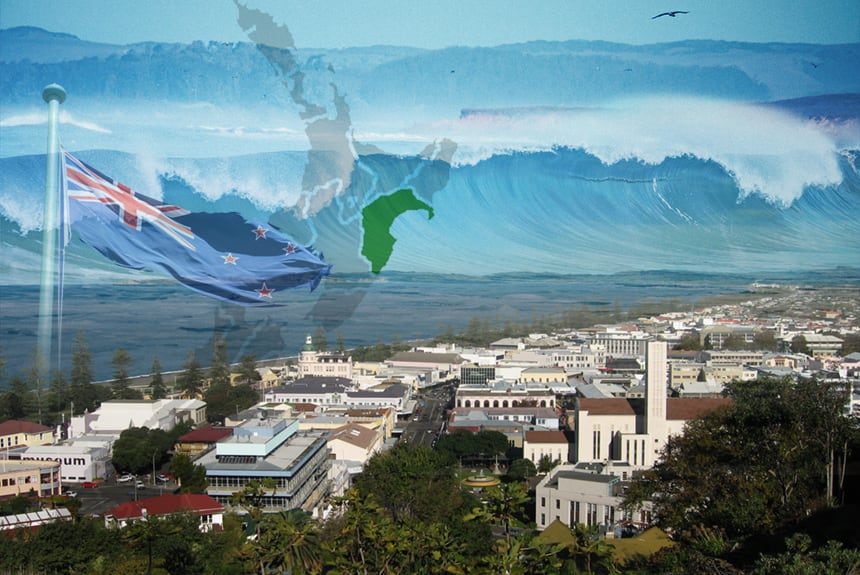Coastal communities in New Zealand are becoming aware of the increasing coastal hazards such as coastal inundation, coastal erosion, and the effects of sea-level rise due to climate change.
The Hawke’s Bay Region is no stranger to coastal threats; the region has faced them and can use this knowledge to prepare for future coastal threats and hazards that will be exacerbated by climate change.
The context for climate change adaptation in Hawke’s Bay.
“Hawke’s Bay is a region of many risks. The Hikurangi subduction zone off the coast stretches down to Kaikoura and poses a significant earthquake and tsunami risk to the entire east coast of New Zealand. Much of Napier has been built on land uplifted during the 1931 earthquake or has been reclaimed since that time. Nearly 8,000 homes are less than 150 centimetres above the spring high tide mark, and a considerable area of the city, including the airport, is less than 50 centimetres above the spring high tide mark. Coastal erosion is a significant hazard, as is coastal inundation.”
“The Heretaunga Plains, a 300 square kilometre alluvial plain which contains Napier, Hastings and Havelock, is subject to flooding risks which are managed using major flood protection works, including pump stations and protective structures such as stop banks.”
“The water table around Napier is often close to the surface, and as such, the city is vulnerable to any rise in groundwater, which compounds risks posed by the highly liquefiable soils found under much of Napier’s low-lying suburbs. The high-water table and flat topography pose significant difficulties in moving stormwater from the city to the sea to prevent localised surface flooding of properties and businesses.”
The region has developed the Clifton to Tangoio Coastal Hazard Strategy 2120, a 100-year approach to coastal hazards impact management to create resilient communities up to 2120.
The Clifton to Tangoio Coastal Hazard Strategy is a coordinated and shared approach between Hastings District Council, Napier City Council, and Hawke’s Bay Regional Council to identify and respond to coastal hazards such as coastal erosion and storm surge inundation, and tsunamis. The strategy also provides a platform to make the most appropriate coastal hazard responses.
The development of the strategy comes in four stages.
- Stage 1 is when the plan was initiated in 2014 and completed in 2016. Hazards and risk identification was made at this stage with the help of a technical study.
- Stage 2 established a framework for decision-making, a mechanism for funding, and cost-sharing between councils.
- Stage 3 is developing confirmed responses to coastal hazards risk, which will start in late 2016 and conclude in mid-2017.
- Stage 4 will see the implementation of response to coastal hazard risk, which will continue over an extended timeframe.
To know more about the strategy, click the link below:
The Ministry for the Environment in Partnership with Hawke’s Bay Regional Council conducted a case study to investigate the challenges the three partner councils – Napier City Council, Hastings District, and Hawke’s Bay Regional council encountered while implementing the Clifton to Tangoio Coastal Hazard Strategy.
According to the report, the strategy is now in stage 4, the Implementation phase. Through interviews and discussions with council officials, they have highlighted three key challenges they face while implementing the Strategy:
- Core responsibilities for adaptation are ambiguous,
- tools and mechanisms to manage current and future hazards are limited or inefficient, and
- there is a lack of agreed approach and principles for sharing costs of works.
Recommendations are also laid out in the report on how Hawke’s Bay Regional Council, Napier City Council, and Hastings District can address these challenges.
“Hawke’s Bay Regional Council, Hastings District Council, and Napier City Council have been leaders in coastal adaptation planning in New Zealand. Due to the progress, they have made, they have also started to push up against some roadblocks that other councils have not yet encountered. For the councils, having invested substantial time, effort, and money into following best practice guidance as it has developed, there is frustration at the idea that this work now risks stalling at the implementation phase.”
To read the case study, click the link below:
Source Citation:
Clifton to Tangoio Coastal Hazards Strategy 2120 Version 2. (2016, August). Retrieved from https://www.hbcoast.co.nz/assets/Document-Library/Assessment-Panel-Report-FINAL-28.2.18-reduced-size.pdf
Ministry for the Environment and Hawke’s Bay Regional Council partnership project. 2020. Case study: Challenges with implementing the Clifton to Tangoio Coastal Hazards Strategy 2120. Wellington: Ministry for the Environment. Retrieved from https://environment.govt.nz/assets/Publications/Files/challenges-with-implementing-the-Clifton-to-Tangoio-coastal-hazards-strategy-2120-case-study.pdf



Leave a Reply